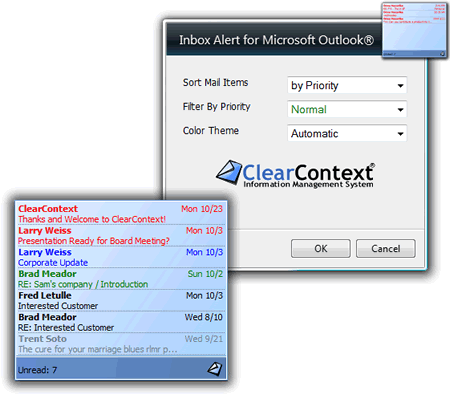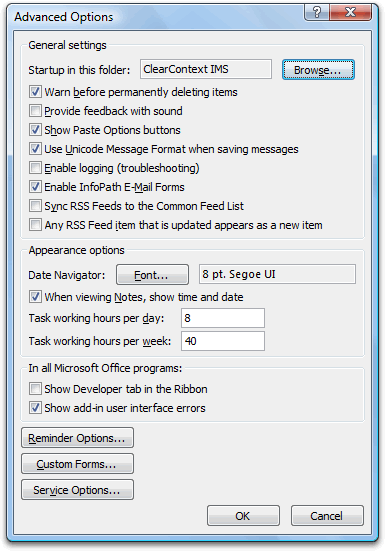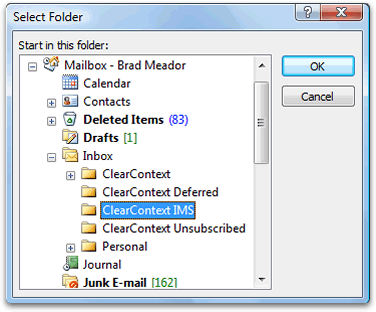 After identifying your priorities and managing your Inbox, succeed by focusing on your work rather than your email:
After identifying your priorities and managing your Inbox, succeed by focusing on your work rather than your email:

Open a Project Dashboard for one of your important projects. Avoid checking email and work on your most important tasks.

When you do check on email, group your Inbox by priority (View > Current View > ClearContext Prioritized by Category) and review only your highest priority messages (in red and green).

Use the MessageContext to see emails, appointments and other related tasks to get the full context for the item you are working on.
By completing the Identify and Manage steps previously, you are free to focus on the work that is most important to you while staying in control of your Inbox.
Tip
Only touch your high priority messages once. Even though you are glancing at these messages throughout the day, make sure that you act on any email you open.
For additional tips for using the ClearContext Daily Workflow, see the following blog posts:
Posted by brad at 11:18 am on September 1st, 2010.
Categories: ims, succeed.
 The Succeed step of the ClearContext Daily Workflow is the ultimate goal of the process. You've identified your priorities for the day and have managed your Inbox. Now, throughout the day, succeed by focusing on your work rather than your email:
The Succeed step of the ClearContext Daily Workflow is the ultimate goal of the process. You've identified your priorities for the day and have managed your Inbox. Now, throughout the day, succeed by focusing on your work rather than your email:

Turn off new mail notifications via Do Not Disturb so that you can work on your tasks without interruption.

Open the ClearContext Dashboard and select a project to work on via the Topic drop down. Work on your most important tasks for the project.

To stay on top of email throughout the day, sort your Inbox by priority (ClearContext > Inbox Views) and review only your highest priority messages (in red and blue) as needed.

Use the MessageContext to see emails, appointments and other related tasks to get the full context for the item you are working on.
One note on the Prioritized step above – if you look at a message during this phase, make sure that you act on any message you open just as you would in the manage phase. You should strive to only touch an Inbox message once.
By completing the Identify and Manage steps previously, you are free to focus on the work that is most important to you while staying in control of your email.
Posted by brad at 10:25 am on September 11th, 2009.
Categories: ims, succeed, tips.

Have you bought into the idea that you should only check email a couple of times a day, but you are worried that you will miss a really important message? Our Vista Gadget is designed for you.
- Download and install the gadget from here.
- Once it’s installed, click the wrench next to the gadget for configuration options.

- Select the priority you want to filter by from the Filter By Priority drop down. I suggest High or Very High.
- Click OK.
Now, when you’re ready to focus on your work for the day, select Do Not Disturb, minimize Outlook, and let the gadget tell you if a really important message arrives.
For more information on the gadget, see the ClearContext Inbox Alert User Guide.
Posted by brad at 11:31 am on March 24th, 2008.
Categories: ims, succeed, tips.
Topic assignment is key to getting the most out of IMS. By assigning Topics to email threads, you ensure that:
In addition, by segmenting messages, tasks and appointments by Topic, you can utilize the full potential of the Dashboard and focus on your work by project.
IMS provides several ways to help you assign Topics:
Sent Message Categorization

Go to ClearContext > Options > Preferences > Topic Options. Enable "Ask about selecting a Topic if one is not assigned." When you compose a message, IMS will check to see if the current conversation has a Topic assigned to it. If not, you will be queried to assign one. This will ensure that future replies to this message will come in pre-assigned with your Topic. Also, if you check "Save messages to Topic Folder" IMS will move the Sent message to the correct Topic folder; keeping both sides of the conversation in the same location.
Task and Appointment Topic Query on Save

Much like Sent Message Categorization, there is a similar Topic Query function available for tasks and appointments. Go to ClearContext > Options > Preferences > Tasks/Appts and check "Ask about selecting a Topic if one is not assigned" for both Tasks and Appointments. IMS will query you for a Topic assignment as you save these items; enabling you to view them by Topic when using the Dashboard.
AutoAssign
As discussed earlier, AutoAssign allows you to quickly create simple rules to automatically assign Topics to incoming messages. This is a huge time-saver; a good set of AutoAssign rules in conjunction with IMS’s automatic assignment of Topics to conversation messages ensures that many of your messages will arrive in the Inbox pre-categorized. For more detail on AutoAssign, see our User Guide.
Posted by brad at 6:30 am on January 25th, 2008.
Categories: ims, maintenance, succeed, tips.
MacLean’s published an article last week on Intel’s quiet time pilot. I like this idea a lot better than Email Free Fridays:
‘Quiet Time, which began in September, happens each Tuesday at two of Intel’s U.S. sites (they won’t reveal exactly where). From 8 a.m. to noon, the 300 engineers and managers in the test group set email and instant messaging to off-line mode, forward all calls to voice mail, and hang “do not disturb” signs at their cubicle entrances. They’re then free to do “thinking work,” says Intel IT principal engineer Nathan Zeldes, the man behind the project. “These guys are designing products, so I would hope they’d devote it to that,” he says. “Although I’m sure some of them are tempted to clean out their inboxes.”‘
This is basically institutionalizing the Succeed step of the IMS process; forcing employees to block out times of the day to focus on project based work rather than responding to constant interruption. And it’s clear from the article that this type of break from the outside world is required to get real work done:
‘Today’s knowledge workers can expect just three minutes of uninterrupted work on any given task, suggests research from Gloria Mark and Victor M. Gonzalez at the University of California, Irvine. “It’s bad for innovation,” Mark says. “To be able to think very deeply, you do need quiet time.”‘
Three minutes? I suspect this is why all my most creative ideas come when I’m walking to work rather than when I’m sitting at my desk.
Thanks to customer Philip who forwarded along this article! Most appreciated…
Posted by brad at 12:45 pm on January 14th, 2008.
Categories: ims, infomania, productivity, succeed.
In the Identify phase of the IMS Daily Workflow, we recommend that you start your day with the Dashboard, reviewing your Tasks and Appointments before moving into Inbox Management.
To take this a step further, you can set Outlook to automatically open the Dashboard on startup, helping you avoid the temptation of looking at your email before you’ve had a chance to identify the day’s priorities. Go to Tools > Options > Advanced Options:

Click the Browse button and select the Inbox sub-folder, ClearContext IMS:

Select OK on this and the Options dialog. Voila! On startup Outlook will open up the Dashboard so that you can size up your day.
Posted by brad at 10:43 am on December 12th, 2007.
Categories: ims, succeed, tips.
 The Succeed step of the IMS Daily Workflow is the ultimate goal of the process. You’ve identified your priorities for the day and have managed your Inbox. Now, throughout the day, succeed by focusing on your work rather than your email:
The Succeed step of the IMS Daily Workflow is the ultimate goal of the process. You’ve identified your priorities for the day and have managed your Inbox. Now, throughout the day, succeed by focusing on your work rather than your email:

Turn off new mail notifications via Do Not Disturb so that you can work on your tasks without interruption.

Open the IMS Dashboard and select a project to work on via the Topic drop down. Work on your most important tasks for the project.

To stay on top of email throughout the day, sort your Inbox by priority (ClearContext > Inbox Views) and review only your highest priority messages (in red and blue) as needed.

Use the RelatedView to see emails, appointments and other related tasks to get the full context for the item you are working on.
One note on the Prioritized step above – if you look at a message during this phase, make sure that you act on any message you open just as you would in the manage phase. You should strive to only touch an Inbox message once.
By completing the Identify and Manage steps previously, you are free to focus on the work that is most important to you while staying in control of your email.
As mentioned in my initial IMS post, this process is distilled down from a wealth of best practices developed over the course of several years. If you have not done so already, subscribe to this blog to receive future tips on best use of IMS to maximize your personal productivity.
Posted by brad at 8:36 am on December 3rd, 2007.
Categories: ims, succeed.
Long time user Craig Kennedy has posted a thorough review of ClearContext IMS v4 and how he applies GTD practice using ClearContext + Outlook as his trusted system:
"Recently ClearContext released version 4 of the Information Management System, and with this release I finally uninstalled the Netcentrics add-in and have moved snugly into ClearContext as my sole workflow tool. What finally tipped the scale for me was the introduction of the Dashboard, a central hub where I can view all my appointments, email messages and tasks according to project. This welcome addition was what turns CC into a GTD powerhouse."
I was most pleased to see that Craig gets the theory behind the IMS Daily Workflow:
"What really knocked my socks off and has served to turbo-charge my work habits is Step 3 in the process, Succeed. … What ClearContext has provided is much needed "context". When I move into the dashboard and begin quickly clicking through my projects, I inevitably find a number of small actionable tasks that I’m all too willing to tackle because I can now see clearly "why" I wanted to do it. By seeing that clear link from task to project, my motivation remains high and I’m getting much more done."
Read the rest of the article is you are looking for additional insight into how to use Outlook and IMS as your trusted system. Also, see our Using IMS with GTD setup guide for additional tips.
On a related note, despite the praise Craig has heaped on the Dashboard, this is just v1.0 of that feature. Future releases will add additional flexibility and interactivity to make it an even more powerful tool for workday management. If you would like to help us prioritize the features we build next, please go to this forum thread and let us know what you would like to see next.
Posted by brad at 2:40 pm on November 30th, 2007.
Categories: gtd, ims, reviews, succeed.
I stumbled across this Ferris Research article on measuring email response time and email SLA’s at Ferris Research. David Sengupta basically says that using email response time as a metric is a sure fire way to develop unproductive work habits in the organization:
“Being hyper-responsive to email around the clock suggests that you live an interrupt-driven work life and that you likely have a hard time concentrating for prolonged periods of time. Your overall productivity is likely to be reduced as a result, making you less valuable.
…
Many people are intensely productive but block hours or even days of email-free time, in order to focus on priority projects. When you hear managers or others in the company suggesting that there is some inherent value in someone’s ability to be instantly responsive to any message that comes their way, or in someone’s ability to process a massive amount of email, think again.”
This is, of course, exactly what we have been saying. Focus on your projects rather than your messages and you’ll be a lot more successful in the long run.
Posted by brad at 10:44 am on November 28th, 2007.
Categories: email, ims, news, succeed.
![]() After identifying your priorities and managing your Inbox, succeed by focusing on your work rather than your email:
After identifying your priorities and managing your Inbox, succeed by focusing on your work rather than your email:![]()




